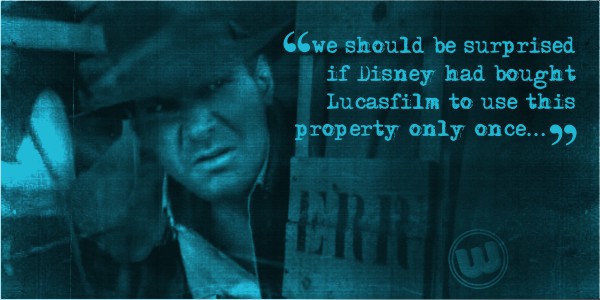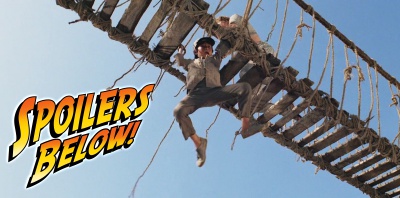
Indiana Jones
And The Dial Of Destiny
(plot-spoilers)
Cert: 12A / 154 mins / Dir. James Mangold / Featurette
I have to admit that after watching Indiana Jones And The Dial Of Destiny three times, I love the film without it having made a huge jarring impact. Much like Solo, this seems to have slotted perfectly into the continuity with no real controversy (other than That Section In The Third Act which will have the usual suspects clutching at their nostalgic pearls, pining for the narrative realism of a magic box out of the Bible full of ghosts). Indy 5 slides deftly into the water rather than making a splash. And ultimately, this is for the best.
If you haven't seen the movie yet, there's a spoiler-free review here and a second one discussing themes here. Everything following the jump contains heavy plot-spoilers. Watch the film first. Hell, watch the film anyway...

Still here? Lovely.
So while it fits seamlessly into the narrative and tonal continuity, the fifth entry in the series does feature a couple of glaring departures from its forebears. And the first of these is the very first thing the audience sees after the ads, trailers and a BBFC/MPAA card, with logos for Disney, Paramount and Lucasfilm. In that order. What this means is that there's no cross-fade from the Paramount mountain-ident into the film's opening scene. Which, frankly, people would expect...

Given that Disney are controlling production and distribution of the property now, it's unclear what part Paramount are playing in Indy 5. But you'd be forgiven for thinking that if the company is important enough to credit with full-screen branding, tradition alone would go so far as transforming the mountain into, perhaps, a pile of spent shell-casings in war-torn 1944?
It's not a huge deal, but this is a real shame and the only thing that's definitively missing (read: fixable) in the whole film.
Dial Of Destiny's other departure from the series is a little more complex...
NAILED
At the end of Raiders, the Ark Of The Covenant is closed and then nailed into a crate, to be kept safely out of harm's way (or at least until the US Government find a way to weaponise it, presumably). Similarly, Temple Of Doom sees the Sankara Stones returned to their people, and Last Crusade has the Holy Grail lost into the earth. Even Crystal Skull closes with the titular bonce being reunited with its owner and skipping off through the space between the spaces. Indy doesn't get to keep these McGuffins like Mr Benn sidling back to Festive Road with a memento. That's very much the point of the movies: archaeology is about acquiring and sharing knowledge rather than just hoarding treasure*1.
But as Dial Of Destiny winds down, a senior Henry Jones Jr wakes in his apartment to the ticking of a clock and a slow camera-pan (a callback to earlier in the film and a gorgeous nod to Back To The Future) with Archimedes' Antikythera sitting on the desk right next to him. Helena's left it there. It comes as no real surprise by this point that she's has decided against selling it off, but the dial is still in Indy's possession. Whether it can be used is up for discussion (and we're about to discuss it), but this is not an accident.
TUDORED
Shortly after, there's a lingering moment in the final scene where Indy and Marion reconnect in his kitchenette as the audience holds its breath for Mutt Williams strolling in through the door, to give a full family reunion. In this event, we would instinctively know that Helena had made an unseen, dial-assisted detour on their way back from the beach at Syracuse, managing to drop in on Mutt to have a quiet word about his upcoming enlistment in the US Army. The conversation between Indy and Helena in the second act where he laments his son's death certainly sets up this eventuality.
This doesn't happen, of course. Helena has already demonstrated (and with far greater clarity than her godfather) that she's got a firm grip on not changing the course of history. She's very eager to avoid inadvertently destroying the present they're trying to get back to*2, and so it appears she's brought everyone home without further chronological adjustment. Which is probably for the best.
SEABROOKED
This also results in a far more poignant ending, as Indy and Marion are rebuilding their relationship again (okay, again again) with wisdom, hope and reflection, rather than having their pain magicked away for a fluffy ending which must have been incredibly tempting in the writers' room.
Bur crucially - and for the first time, cinematically - Indy still has the item he's spent the last two and a half hours chasing. This movie may be marketed as the final cinematic outing for Jonsey, but we should be surprised if Disney had bought Lucasfilm to use this particular property only once. And as the final frames in the streets of New York show us, the man is incapable of hanging up his hat for good. Just what form future (or past) adventures will take is unclear, but Helena and the four screenwriters left the dial with Indy for a reason.
SPACE RAIDERED
Then again, crammed into the third-act catchup exposition is the idea that the Antikythera is 'a forced deck'. That it only ever calculated a portal to travel back to Syracuse in 213 BC and that was its sole purpose. Because if Archimedes' time-fissures are happening anyway and the dial is merely a signpost, why has nobody accidentally discovered one without it? Do these rifts always occur in the air and during a storm, so you'd need to be mad to fly into one? And it still doesn't explain why, by 1969, the world hasn't had visitors or explorers from the future. Or maybe it has? The dial isn't a time-machine per se, but it demonstrably makes time travel possible.
Basil Shaw's decryption notes only show us limited references to to/from dates, and even this is vague since he hadn't figured it all out. So do we assume that Archimedes managed to reverse-calculate 1969's entry-point, knowing that the journey must work because he'd seen the result of it in his own past? That fits with the time travel coil-theory and would make this a One And Done item. In which case - its power spent - the Dial Of Destiny itself fits neatly among its enchanted peers. Not quite so different, after all. Indy can finally get one of his artefacts safely into a museum.
Unless he holds on to it again, of course. Just to remind him...

*1 A point literally spelled out by John Hurt's Harold Oxley in the fourth instalment, much derided and yet encapsulating the series perfectly. That movie is underrated. I digress. [ BACK ]
*2 Let's not get into the fact that Dial Of Destiny does leave a Syracuse coastline whose archaeological remains apparently contain a two thousand year-old HE-111 bomber plane, along with the non-perishable badges, buttons and firearms of all the nazis who fell out of it. Although because of the film's fixed-approach to time travel, those items were always there anyway. So fair play I suppose. Still, it's odd that in 1969 nobody has found these. Then again, Antonio Banderas' diving crew finally manage to be the ones to stumble across a sunken galleon full of ancient gold that everyone in the local fishing community knew about which is in water so shallow it can conceivably be seen from the surface on a sunny day, so... [ BACK ]
DISCLAIMERS:
• ^^^ That's dry, British humour, and most likely sarcasm or facetiousness.
• Yen's blog contains harsh language and even harsher notions of propriety. Reader discretion is advised.
• This is a personal blog. The views and opinions expressed here represent my own thoughts (at the time of writing) and not those of the people, institutions or organisations that I may or may not be related with unless stated explicitly.

No comments:
Post a Comment